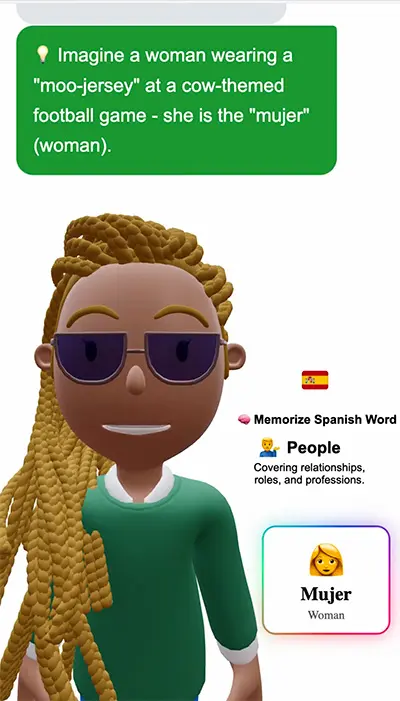
If you’re wondering what TPRS language learning is—it’s a proven input-based method that teaches foreign languages through storytelling, repetition, and comprehensible input, so you can speak naturally without memorizing endless grammar rules. TPRS (Teaching Proficiency through Reading and Storytelling), created by Blaine Ray, helps learners acquire a language the same way children do—by hearing, understanding, and using it in real-life contexts rather than just memorizing a grammar rule.
Table of Contents
Open Table of Contents
- What is TPRS Language Learning?
- Why TPRS Works So Well
- Step-by-Step: How TPRS Lessons Work
- Example: TPRS in Action
- Benefits of TPRS Language Learning
- How to Start TPRS Language Learning
- TPRS vs. Traditional Language Learning
- Common Myths About TPRS
- Resources for TPRS Language Learning
- Tips for Maximizing TPRS Effectiveness
- The Future of TPRS Language Learning
- Final Thoughts
What is TPRS Language Learning?
TPRS stands for Teaching Proficiency through Reading and Storytelling, a language teaching method that combines Total Physical Response (TPR) with reading activities. Inspired by Dr. James Asher’s TPR method and expanded by Blaine Ray (a Spanish teacher), it focuses on providing learners with comprehensible input—language they understand—so they absorb grammar and vocabulary naturally.
The method is typically broken down into three main steps:
- Establish Meaning – Introduce new words and phrases with clear meanings in the target language.
- Ask a Story – Use questions to co-create a story with individual students.
- Read and Discuss – Reinforce the story through reading and guided conversation.
Why TPRS Works So Well
1. Natural Language Acquisition
Following Dr. Stephen Krashen’s language acquisition strategies, TPRS mirrors how children learn their first language—by understanding meaningful messages in context.
2. High Engagement
Stories are inherently interesting, keeping learners emotionally invested and motivated.
3. Long-Term Retention
Repetition inside stories helps vocabulary and grammar stick without tedious memorization.
4. Comprehensible Input
TPRS classrooms always deliver language that is understandable but slightly challenging, fostering growth.
Step-by-Step: How TPRS Lessons Work

Here’s what a typical TPRS classroom lesson might look like:
Step 1 – Establish Meaning
- Introduce 2–3 new target language phrases.
- Provide translations and use gestures for memory reinforcement.
- Connect vocabulary to student experiences.
Step 2 – Ask a Story
- Ask personalized questions using the new phrases.
- Students’ answers are woven into a fun, unexpected storyline.
- Encourage acting to create total physical response storytelling moments.
Step 3 – Read and Discuss
- Read the co-created story together.
- Ask comprehension questions.
- Highlight grammar rules in context instead of isolated drills.
Example: TPRS in Action
Target phrases:
- veut manger – wants to eat
- un sandwich au fromage – a cheese sandwich
The teacher might ask:
- “Who wants to eat a cheese sandwich?”
- “Where is the cheese sandwich?”
- “Why does he want to eat it?”
Students respond, and a drama unfolds:
“Sophie is in Paris. She wants to eat a cheese sandwich, but the café is closed. She travels to Lyon and meets a chef who only makes giant sandwiches…”
This interaction keeps learners speaking without realizing they’re practicing grammar rules.
Benefits of TPRS Language Learning
| Benefit | Why It Matters |
|---|---|
| High Retention | Vocabulary sticks thanks to meaningful, repeated use. |
| Confidence Boost | Students speak earlier and with less hesitation. |
| Adaptability | Works for any foreign language and age group. |
| Low Anxiety | Reduces fear of mistakes through fun stories. |
| Cultural Insight | Storytelling naturally integrates cultural elements. |
How to Start TPRS Language Learning
Whether you’re a learner or a language teacher, here’s how to begin:
For Learners
- Find TPRS Content – Look for YouTube videos, podcasts, or books from TPRS teachers.
- Prioritize Listening and Reading – Focus on input-based learning.
- Repeat and Retell – Hear the same story multiple times, then summarize it.
- Personalize Stories – Replace characters with people you know.
- Track Progress – Monitor your ability to understand and produce the target language.
For Teachers
- Start Small – Introduce a few new phrases per lesson.
- Engage Individual Students – Build stories from their interests.
- Recycle Vocabulary – Bring old words into new contexts.
- Encourage Acting – Movement boosts memory in line with Total Physical Response TPR principles.
TPRS vs. Traditional Language Learning
| Feature | TPRS | Traditional |
|---|---|---|
| Focus | Comprehensible input | Grammar & drills |
| Speaking | Immediate | Often delayed |
| Engagement | Story-driven | Textbook-focused |
| Retention | High | Lower |
| Anxiety | Low | Higher |
Common Myths About TPRS
- “It’s only for beginners.” – Works for all levels; adjust story complexity.
- “It ignores grammar.” – Grammar is integrated, not avoided.
- “It’s just for kids.” – Adults thrive in TPRS classrooms too.
Resources for TPRS Language Learning
- Books: Fluency Through TPR Storytelling by Blaine Ray & Contee Seely.
- YouTube: Search for live TPRS classrooms.
- Podcasts: Slow storytelling in your target language.
- Communities: TPRS groups for language teachers and learners.
Tips for Maximizing TPRS Effectiveness
- Emotional Engagement – Remembering is easier when you care about the story.
- Tolerate Uncertainty – Don’t translate every word.
- Practice Retelling – Strengthens sentence structure.
- Mix in Cultural Content – Adds authenticity.
- Be Consistent – Daily short sessions beat long sporadic ones.
The Future of TPRS Language Learning
With AI-powered tools and interactive platforms, TPRS method resources are expanding. Some apps now create custom stories for individual students, making language learning more immersive.
Final Thoughts
TPRS language learning isn’t just another method—it’s a natural, enjoyable, and highly effective approach to mastering a foreign language. By combining Total Physical Response TPR, storytelling, and comprehensible input, you can achieve fluency faster while having fun.
Start today: pick a short story in your target language, listen, retell, and watch your skills grow.